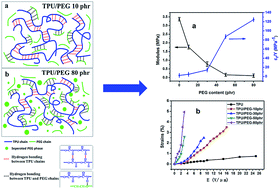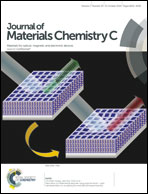Largely improved actuation strain at low electric field of dielectric elastomer by combining disrupting hydrogen bonds with ionic conductivity
Abstract
Dielectric elastomer actuators (DEAs) can lead to surprisingly large deformations by applying an electric field. The biggest challenge for DEAs is to get a large actuated strain at a low electric field. Herein, a novel approach was used to largely improve the actuated strain at a low electric field of a thermoplastic polyurethane (TPU) dielectric elastomer (DE) by introducing polyethylene glycol (PEG) oligomer into the matrix. The dielectric constant (εr) of TPU was obviously increased by adding PEG due to the combined effect of the increase in the interfacial polarization ability of TPU/PEG blends by the ionic conductivity of PEG and the increase in dipole polarization ability of TPU chain segments by the disruption of hydrogen bonds of TPU chains. Meanwhile, the elastic modulus (Y) of TPU was obviously decreased due to the plasticizing effect of PEG on TPU. The simultaneous increase in εr and decrease in Y resulted in a 7500% increase in actuated strain at a low electric field (3 V μm−1) by adding PEG. The actuated strain (5.22% at 3 V μm−1) is considerably higher than that of other DEs at the same electric field reported in the literatures. Our work provides a simple and effective method to largely improve the actuated strain at a low electric field of a DE, facilitating the application of DE in biological and medical fields.


 Please wait while we load your content...
Please wait while we load your content...